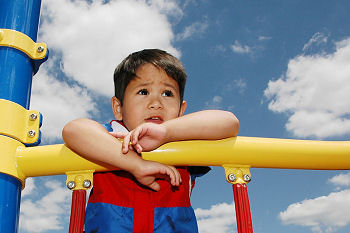Many people avoid flash photography because of the unnatural and unflattering look it can create. The problem comes from several factors which I’ll talk about in more detail in future articles. For now, I want to talk about a way to use your flash that can not only enhance the natural beauty of a scene, but no one will even be able to tell that a flash was used.
The technique is called fill flash because it is used to “fill” in shadows to create more even lighting on your subject. Done properly, fill flash blends seamlessly with existing lighting for a very natural and pleasing effect.
When you use a flash in the dark, you are using it as the primary source of light. Fill flash, on the other hand, is used only to enhance an existing light source. In fact, one of the best times to use fill flash is in broad daylight! In the example below, I wanted to properly expose the subject but I also wanted to capture the very bright clouds. Without fill flash, I could have exposed the subject correctly but the bright blue sky would have been washed out. With fill flash, the extra light from the flash brightens the subject and I’m able to capture a rich blue sky and all of the details in the clouds.

So how do you do it? It’s as simple as turning on your flash. If your camera is set on automatic, it should automatically adjust the flash output and exposure to take into account the natural lighting and attempt to blend the additional flash lighting in. If your camera has something called flash output compensation, you may want to experiment with that to manually adjust the flash output. Sometimes you need to decrease the flash output slightly so that it doesn’t overpower the existing lighting. Remember, you just want to kiss the scene with the extra light from your flash to bring a little extra light into the dark areas.
Fill flash can be used to great effect almost any time you have existing lighting. It can be used to brighten a subject when you are shooting against a bright background (which typically makes your subject too dark). You can use it to soften harsh shadows on a person’s face when the sun is beating straight down on them. Almost any time you have uneven or harsh lighting is the time to think of fill flash. Just that little bit of extra light can open up dark shadows, saturate colors, and really make your photos pop.









I’ve been experimenting with this myself. Good stuff!
Great article, thanks! Ill give it try.
Fantastic, thank you so much for sharing that!
I prefer to shoot in aperture-priority mode on my DSLR. I find that using the pop-up flash over-exposes the photo most of the time, so I don’t usually think of using it. The problem for me is that if I’m using a large aperture to get shallow DOF, then it’ll overexpose the expose the foreground a lot. Any suggestions as to how I can get a large aperture and still use fill flash?
Turning down the flash output should help. Since you’re using a DSLR, you should get an external flash. One that you can position off-camera is even better (either via a cable or wireless). Then you have the option of turning down the output and/or moving the flash farther away.
yes this is soo me.. i never used fill flash.. and might try later ;P thx.. but i really dont know how to set it up the flash output on my d50
When doing isolation photos, you’ll probably want to manually set your exposure when your subject fills the camera. Leave the settings and recompose the scene. Viola! Correct exposure, no flash, and a possibly overexposed but out of focus background.
The fill flash technique could have saved me a couple of times when I wanted to do a candid and there was a window nearby. The window threw off the meter and the person was underexposed. I hear your pain about the over exposed flash. The in camera flash is usually pretty harsh. Outdoors in bright light it will be less noticed though.
Some of modern DSLRs, including whole Nikon line for sure, support manual exposure correction in the apperture-priority mode. That is to say, you can let the device detect the exposure automatically and then shift it N-steps in any direction. On Nikons, there’s small +/- key near the “shoot” button. I’m sure all major DSLRs have it somewhere because apperture-priority mode whouldn’t be much useful without it.